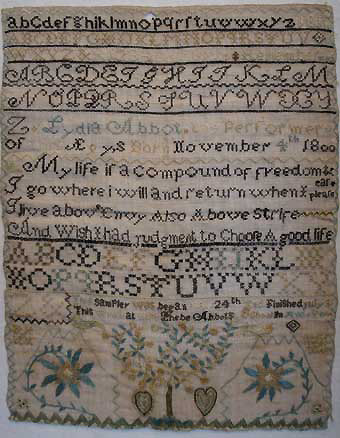
A showy presentation of early schoolgirl sampler keepsakes unearthed from an old trunk. Author’s collection.

This style of a school girl sampler is often referred to as the “Quaker style” and sometimes Shaker style even though there is no history that could be found on this particular piece. This example signifies a common pattern that was implemented during the 1830’s and 1840’s period. The linen chosen to create this sampler has an open weave pattern which suggests this fabric was used for sampler making. Courtesy of “Pat Hatch Antiques”.

Beautiful schoolgirl sampler with an acute emphasis on design and a story that reads: “Lydia Abbot the Performer of this 9 years Born November 4, 1800. My life is a compound of Freedom & I go where I will and return when I please I live abov(e) Envy also above strife And wish I had judgement to choose a good life. This sampler was began may 24th and finished July 31 This wrot at Miss Phebe Abbot’s School in Andover (Massachusetts)”. Courtesy of “Pat Hatch Antiques”.
Each stitch was executed usually in the most common cross-stitch pattern and taught children patience along with learning their numbers and ABC's. These early worked samplers would act as a prerequisite for children to become adept at the needlework skills which would serve them well in the future when they got married and set up fundamental housekeeping. Each "Huswife" would have to keep track of her highly prized linens and this was accomplished by marking them using a cross-stitch pattern with her initials and a number.
The earliest known American sampler was fashioned by "Loara Standish" around 1645 in the Plymouth Colony. By the late 1700's and first quarter of the 19th century "dame" schools (small community schools) and boarding schools were available for well-to-do young ladies.
These schools incorporated teaching the art of needlework on a more extensive and sophisticated level as decorative motifs were implemented using verses, flowers, houses, pastoral designs, religious teachings from the bible and mourning scenes.

A close up representation of Lydia’s sampler showing a stylized fruit tree with two hearts underneath the raised branches. One heart is larger than the other possibly representing her mother and father. Two large flowers that lend folk art flavor appear on either side sporting hues of cornflower blues and crushed oak bark. Courtesy of “Pat Hatch Antiques”
Early samplers depicted different lettering styles and some of the letters were excluded altogether. The ancient Latin alphabet only consisted of twenty three letters and the English were greatly influenced by the Roman's. The letter "W" and "Z" were seldom used. However "U", "V", "J" and "I" were interchangeable. The letter "J" began to form its own distinctive look in the 1820's while the lower case "s" could be mistaken for an "f". Another tricky letter was the "Q" as it was worked as a reversed "P".

This plain and simple example of an 1830 Marking Sampler executed on homespun linen with blue thread would have been kept in a sewing basket and used as a guide for initialing linens and sheets as well as pillow cases, clothing, hankies, etc…..so the initials would always look alike. Note: The letter “q” is worked as a reversed “p”. Courtesy of “Pat Hatch Antiques”.
School girl samplers can be described as charming and quaint as they are expressive forms of art created by adoring children that have been passed down as memorable keepsakes. It is truly amazing to imagine their nimble little fingers busily executing each stitch with their best efforts. I am quite sure these children would be honored to know their efforts are appreciated as these cherished heirlooms proudly grace our walls in most collector's homes.

This endearing and bright Marking Sampler (not dated) is of French origin and boasts two opposing folk art birds near the bottom. A contemporary grain painted frame fashioned by Noreen Taylor of Delaware accents this sampler lending vivid detail. Author’s collection.
Source: Michelle Gardner @ Gundy Farm in Pennsylvania, is a freelance writer / photographer who also is an antique dealer. She has a website you can visit by clicking on the link below:



